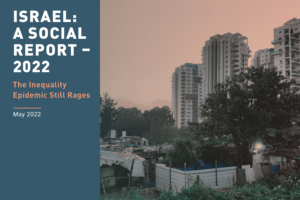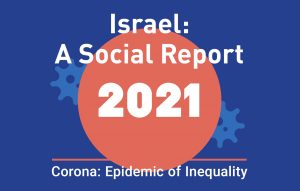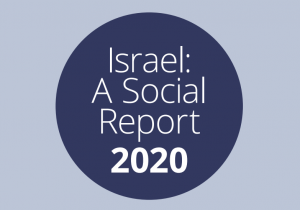The report challenges the routine government position with regard to social maladies: economic growth and still more economic growth. The figures belie the reliance on economic growth
Since the end of the second intifadah, Israel’s economy has been growing: between 2000 and 2014, GDP increased by an average of 3.3% per year, higher than the average economic growth of OECD countries — 1.6%. Thus we would expect this growth to be reflected in the welfare of Israelis as a whole. However this has not happened: the median wage has hardly changed.
Long-range figures from the National Insurance Institute show that for some 25 years, and especially since the end of the second intifadah, the increase in GDP per capita in Israel has not been accompanied by a corresponding increase in real wages; in 2014, the gap between the two was larger than ever.
Below are some of the main findings of the new report:
1) Rather than trickling downwards, the fruits of economic growth have been trickling upwards, against the laws of nature.
- The share of employers in the national income increased from 14% to 17% over the last decade (2014-2014), and the share of workers decreased, from 61% to 57%.
- The salaries of senior executives increased over time: the cost of the salary of directors-general of the 100 largest corporations traded on the Tel Aviv Stock Exchange in 2014 averaged NIS 5.01 million per year, or NIS 417 thousand per month. The average annual cost of the salaries of the five highest earners in these companies amounted to NIS 3.64 million, or NIS 303 thousand per month. These figures are lower than they were in 2013, but they are still beyond the wildest dreams of the vast majority of Israelis.
- In 2014, the average cost of the salaries of the five highest earners in the top Tel Aviv corporations was 32 times the average wage (NIS 9,373 – Israeli workers only) and 70 times the minimum wage (NIS 4,300).
- 3% of Israeli wage earners received (in 2013) the minimum wage or less.
- 1% of Israeli wage earners received salaries characterized by the OECD as low – less than two-thirds of the median wage. This is a high percentage relative to other OECD countries.
- In the lower echelons of the wage scale, women are over-represented: in 2013, 32.5% of women’s wages were at the level of the minimum wage or below, compared with 18.1% of men’s wages.
- Over-representation in the lower echelons is also characteristic of Arab workers: in 2014, their average wage was 29% below the national average. The average wage of Mizrahi workers was 12% above the national average, and that of Ashkenazi workers 38% above the national average.
2) In October 2015 the average unemployment rate was low – 5.3%. However,
- The national average fails to reveal the differences among localities and ethnic groups. An analysis by locality shows that Arab localities top the unemployment list, and that the Bedouin localities in the Negev are at the very peak. The largest Bedouin locality, Rahat, had an unemployment rate of 31.4% in March 2015. Similar rates were to be found among some of the Arab localities in the North – Umm el Fahem (29.8%), Arrabe (28/8%), Sahnin (25/3%), Tamra (23/7%) and Maghar (23.4%). In most of the Jewish localities, the unemployment rate was below 5%, but much higher rates were to be found in development towns like Dimona (15.1%) and Yeruham (13.8%).
- The high road to a better socio-economic future goes through education. The highest paying professions require a college education.
- But in 2014, only 29.1% of young people who were 17 years old in 2006 had begun studying in an institute of higher learning recognized by the Council on Higher Education, and the rate of Jews was twice that of Arabs. If we add those who enrolled in either the Open University or teachers’ colleges, we arrive at about one-third of the age cohort.
- In the 2013/2014 academic year, 13.8% of young people between the ages of 20 and 29 were enrolled in universities and academic colleges. The breakdown by locality reveals a high degree of inequality: 22.2% of young people from affluent localities, 12.6% from Jewish development towns, and 8.4% from Arab localities.
- The main reason for the low percentage of young people going on to college is the low percentage succeeding in the matriculation exams. In 2013, that percentage — 53.4% — exceeded 50% for the first time, but it experienced a slight decrease in 2014.
- Graduates of high school academic tracks attend college at higher rates than graduates of vocational tracks – 42.2% compared with 33.1%. Most of the schools belonging to the large vocational networks – 71% — are located in Jewish development towns and Arab localities. Those found in affluent localities are usually located in their southern neighborhoods.
3) All of the above figures are reflected in health statistics. Health status is connected to quality of life and in general, to class differences – quality of nutrition, quality of the environment and of housing, level of awareness of health hazards, public transportation, employment, accessibility of health services and more. Differences in the general quality of life can be seen in two major indicators of health used throughout the world: infant mortality and life expectancy.
- In 2013, average infant mortality in Israel was 3.1 for every 1,000 live births. This figure placed Israel in 14th place among OECD nations. Infant mortality has declined sharply since the 1970s among both Jews and Arabs. Still, the most recent figures (2010-2014) indicate that infant mortality among Arabs in Israel (6.4) is 2.6 times that among Jews (2.6).
- A similar situation prevails with regard to life expectancy. In 2013, the average life expectancy at birth of men in Israel – 80.3 years – placed it third among OECD nations. The average life expectancy of women in Israel – 83.9, despite its being higher than that of men, placed it in 11th place among OECD nations. While life expectancy is on the rise, it is higher for Jewish men (81.1) than for Arab men (76.8), and the life expectancy of Jewish women (84.5) is higher than that of Arab women (81.2).
4) When it comes to dealing with social issues, the government of Israel looks to economic growth as the panacea, but as we have seen, the fruits of growth trickle up more than down. Reducing inequality requires strong state intervention. The problem is that successive governments have reduced their own abilities to act, especially their budgetary capabilities. The result is a waning of the social services provided by the state: education, health, welfare and social security services. Government expenditures (including transfers to local authorities) amounted to 41.2% of GDP in 2014, placing Israel close to Eastern European countries and others with a tradition of low government spending like New Zealand and Canada (whose defense expenditures are lower than Israel’s).
Not only that: Israeli governments are concerned primarily with security problems, first and foremost with the Palestinian conflict, expressed as it is in frequent violent confrontations. As such, Israel’s governments are not disposed to develop long-term plans to increase success rates in the matriculation exams, to buttress the student population or to broaden the limits of “the start-up nation” beyond “the state of Tel Aviv.”





